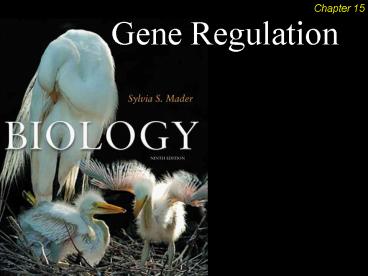Photosynthesis - PowerPoint PPT Presentation
Title:
Photosynthesis
Description:
One to several genes coding for enzymes of a metabolic pathway ... Changes one codon to a different codon. Affects on protein vary: Nonfunctional ... – PowerPoint PPT presentation
Number of Views:24
Avg rating:3.0/5.0
Title: Photosynthesis
1
(No Transcript)
2
Outline
- Prokaryotic Regulation
- trp Operon
- lac Operon
- Eukaryotic Regulation
- Transcriptional Control
- Posttranscriptional Control
- Translational Control
- Posttranslational Control
- Genetic Mutations
- Cancer
3
Prokaryotic RegulationThe Operon Model
- Operon consist of three components
- Promoter
- DNA sequence where RNA polymerase first attaches
- Short segment of DNA
- Operator
- DNA sequence where active repressor binds
- Short segment of DNA
- Structural Genes
- One to several genes coding for enzymes of a
metabolic pathway - Translated simultaneously as a block
- Long segment of DNA
4
Repressible OperonsThe trp Operon
- The regulator codes for a repressor
- If tryptophan (an amino acid) is absent
- Repressor is unable to attach to the operator
(expression is normally on) - RNA polymerase binds to the promoter
- Enzymes for synthesis of tryptophan are produced
- If tryptophan is present
- Combines with repressor as corepressor
- Repressor becomes functional
- Blocks synthesis of enzymes and tryptophan
5
The trp Operon
6
Inducible OperonsThe lac Operon
- The regulator codes for a repressor
- If lactose (a sugar that can be used for food) is
absent - Repressor attaches to the operator
- Expression is normally off
- If lactose is present
- It combines with repressor and renders it unable
to bind to operator - RNA polymerase binds to the promoter
- The three enzymes necessary for lactose
catabolism are produced
7
The lac Operon
8
Action of CAP
9
Eukaryotic Regulation
- A variety of mechanisms
- Five primary levels of control
- Nuclear levels
- Chromatin Packing
- Transcriptional Control
- Posttranscriptional Control
- Cytoplasmic levels
- Translational Control
- Posttranslational Control
10
Regulation of Gene ExpressionLevels of Control
in Eukaryotes
11
Chromatin Structure
- Eukaryotic DNA associated with histone proteins
- Together make up chromatin
- As seen in the interphase nucleus
- Nucleosomes
- DNA wound around balls of eight molecules of
histone proteins - Looks like beads on a string
- Each bead a nucleosome
- The levels of chromatin packing determined by
degree of nucleosome coiling
12
Levels of Chromatin Structure
13
Chromatin Packing
- Euchromatin
- Loosely coiled DNA
- Transcriptionally active
- Heterochromatin
- Tightly packed DNA
- Transcriptionally inactive
- Barr Bodies
- Females have two X chromosomes, but only one is
active - Other is tightly packed along its entire length
- Inactive X chromosome is Barr body
14
X-Inactivation in Mammalian Females
15
Transcriptional Control
- Transcription controlled by proteins called
transcription factors - Bind to enhancer DNA
- Regions of DNA where factors that regulate
transcription can also bind - Always present in cell, but most likely have to
be activated before they will bind to DNA
16
Lampbrush Chromosomes
17
Initiation of Transcription
18
Posttranscriptional Control
- Posttranscriptional control operates on primary
mRNA transcript - Given a specific primary transcript
- Excision of introns can vary
- Splicing of exons can vary
- Determines the type of mature transcript that
leaves the nucleus - May also control speed of mRNA transport from
nucleus to cytoplasm - Will affect the number of transcripts arriving at
rough ER - And therefore the amount of gene product realized
per unit time
19
Processing of mRNA Transcripts
20
Translational Control
- Translational Control - Determines degree to
which mRNA is translated into a protein product - Presence of 5' cap
- Length of poly-A tail on 3' end
- Posttranslational Control - Affects the activity
of a protein product - Activation
- Degradation rate
21
Effect of Mutations onProtein Activity
- Point Mutations
- Involve change in a single DNA nucleotide
- Changes one codon to a different codon
- Affects on protein vary
- Nonfunctional
- Reduced functionality
- Unaffected
- Frameshift Mutations
- One or two nucleotides are either inserted or
deleted from DNA - Protein always rendered nonfunctional
- Normal THE CAT ATE THE RAT
- After deletion THE ATA TET HER AT
- After insertion THE CCA TAT ETH ERA T
22
Point Mutation
23
Androgen Insensitivity
24
Carcinogenesis
- Development of cancer involves a series of
mutations - Proto-oncogenes Stimulate cell cycle
- Tumor suppressor genes inhibit cell cycle
- Mutation in oncogene and tumor suppressor gene
- Stimulates cell cycle uncontrollably
- Leads to tumor formation
25
Carcinogenesis
26
Achondroplasia andXeroderma Pigmentosum
27
Causes of Mutations
- Replication Errors
- 1 in 1,000,000,000 replications
- DNA polymerase
- Proofreads new strands
- Generally corrects errors
- Environmental Mutagens
- Carcinogens - Mutagens that increase the chances
of cancer - Ultraviolet Radiation
- Tobacco Smoke
28
Review
- Prokaryotic Regulation
- trp Operon
- lac Operon
- Eukaryotic Regulation
- Transcriptional Control
- Posttranscriptional Control
- Translational Control
- Posttranslational Control
- Genetic Mutations
- Cancer
29
(No Transcript)































